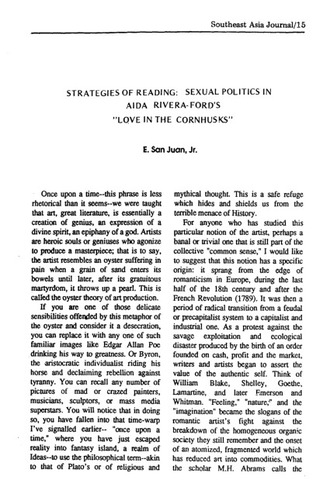Strategies of reading: Sexual politics in Aida Rivera-Ford's "Love in the cornhusks"
摘要
Once upon a time-this phrase is less rhetorical than it seems-we were taught that art, great literature, is essentially a creation of genius, an expression of a divine spirit, an epiphany of a god. Artists are heroic souls or geniuses who agonize to produce a masterpiece; that is to say, the artist resembles an oyster suffering in pain when a grain of sand enters its bowels until later, after its gratuitous martyrdom, it throws up a pearl. This is called the oyster theory of art production.
If you are one of those delicate sensibilities offended by this metaphor of the oyster and consider it a desecration, you can replace it with any one of such familiar images like Edgar Allan Poe drinking his way to greatness. Or Byron, the aristocratic individualist riding his horse and declaiming rebellion against tyranny. You can recall any number of pictures of mad or crazed painters, musicians, sculptors, or mass media superstars. You will notice that in doing so, you have fallen into that time-warp I’ve signaled earlier- "once upon a time," where you have just escaped reality into fantasy island, a realm of Ideas-to use the philosophical term-akin to that of Plato’s or of religious and mythical thought. This is a safe refuge which hides and shields us from the terrible menace of History.
描述
Journal article
建议引文
San Juan, E. Jr. (1989). Strategies of reading: Sexual politics in Aida Rivera-Ford's "Love in the cornhusks".文件类型
Article國際標準期刊編號
0038-3600集合
- Southeast Asia Journal [188]


